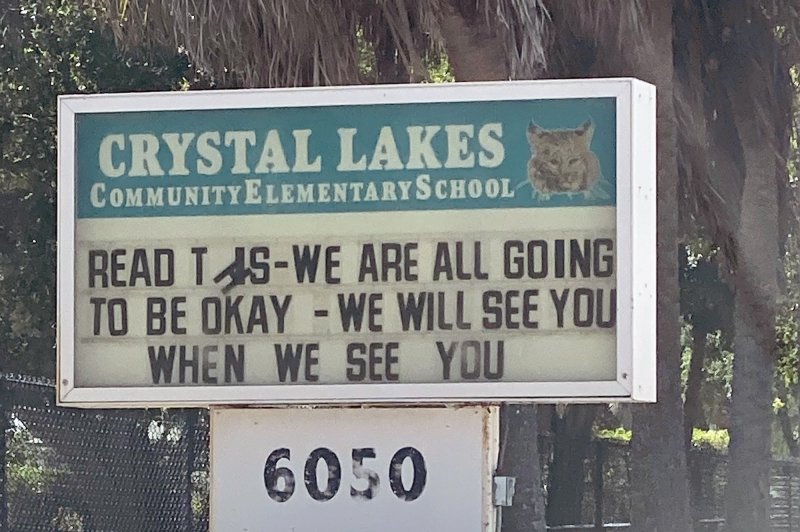A message on the Crystal Lakes Elementary School notice board reassures students during the school closing due to the coronavirus fears in Boynton Beach, Florida, on March 28. Photo by Gary I Rothstein/UPI |
License Photo
At least 1 in 7 U.S. healthcare workers have to miss work to care for their children if the coronavirus pandemic keeps schools closed -- and their absence could result in more patient deaths, researchers say.
Teams from Yale University and Colorado State University used U.S. Census data to project the child care needs of healthcare workers.
"Closing schools comes with many trade-offs, and can create unintentional child care shortages that put a strain on the healthcare system," said study co-lead author Eli Fenichel, associate professor of bioeconomics and ecosystem management at Yale.
About 29 percent of U.S. healthcare workers have children between 3 and 12 years of age, the analysis showed. In households without a non-working adult or a sibling age 13 or older to care for them, 15 percent of healthcare workers will require child care if schools close.
If they can't make other child care arrangements, their absence could compromise the ability of the U.S. healthcare system to respond to the coronavirus pandemic, the study published April 3 in The Lancet Public Health journal warned.
The authors noted, however, that precise forecasts of the effect of school closures on coronavirus deaths are difficult. They said that's due to conflicting estimates of virus transmission and infectivity, and how having fewer healthcare workers affects survival of patients with COVID-19.
"Closing schools and distancing in general is about bending the curve to stay below hospital capacity and reduce COVID-19 mortality, but how we distance in order to bend the curve can also influence the hospital capacity we need to stay below. We need to account for both," Fenichel said in a journal news release.
Understanding the trade-offs is key to planning the public health response to COVID-19, he said.
"If the survival of infected patients is sufficiently sensitive to declines in the healthcare workforce, then school closures could potentially increase deaths from COVID-19," Fenichel added.
The analysis projected that school closures would be especially difficult for nurse practitioners (22 percent will need child care); physician assistants (21 percent); diagnostic technicians (19 percent); physicians and surgeons (16 percent); and nearly 13 percent of aides who are single parents and helping with infection control in nursing homes.
States most likely to have unmet child care needs among healthcare workers include South Dakota, Oregon and Missouri (21 percent in these states will need child care).
States least likely to have unmet child care needs include New Mexico (10 percent); and New Jersey (11 percent).
The researchers estimated that if the death rate among infected patients rises from 2 percent to more than 2.4 percent and the number of healthcare workers falls by 15 percent, school closures could result in more deaths than they prevent.
"The U.S. healthcare system appears disproportionately prone to labor shortages from school closures, particularly among those healthcare workers providing infection control in nursing homes," said co-lead author Jude Bayham, an assistant professor of agricultural and resource economics at Colorado State.
"These potential health-care workforce shortages should be a priority when assessing the potential benefits and costs of school closures, and alternative child care arrangements must be part of the school closure plan," he added.
More information
The U.S. Centers for Disease Control and Prevention has more on the new coronavirus.
Copyright 2020 HealthDay. All rights reserved.
![]()
















